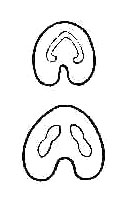|
Hardy Fern Home D. pycnocarpon resources All Ferns � Woodsiaceae �� Diplazium
�Other Genera
|
| Diplazium pycnocarpon | ||
Glade fern | ||
|
Etymology
From pycnos, close, or dense, + carpos, fruit.
Description
Rhizome: short-creeping, 5 mm. diam., stipes 1-2 cm. distant, scales brown or tan, broadly lanceolate.
Frond: 100 cm high by 20 cm wide, deciduous, somewhat dimorphic, fertile fronds taller, erect, sterile arching, blade/stipe ratio: 3:1. Stipe: reddish-brown at base, green upwards, deeply grooved above, a few scales near the base, vascular bundles: 2, curved or peanut-shaped, at an acute angle, uniting to a v-shape above. Blade: 1-pinnate, oblong-lanceolate, � narrowed to base, herbaceous to papery, glabrous. Pinnae: 20 to 40 pair, linear, 1 cm wide; costae grooved above, continuous from rachis to costae; margins entire to crenate; veins free, forking. Sori: linear or slightly curved , running from midvein halfway or almost to the margin in a herringbone pattern, indusium: linear, persistent, translucent, sinus, sporangia: black, maturity: late summer. Culture
Habitat: moist woods and slopes in neutral soil .
Distribution: eastern North America.
Hardy to -30�C, USDA Zone 4.
Distinctive Characteristics
Narrow, pinnate blades are distinctive. Diplazium pycnocarpon is often placed in the genus Athyrium. FNA assigns it here, calling the usual criterion --�elongate back-to-back sori --�rare. So rare that no photographic example could be found.
Synonyms
Asplenium pycnocarpon Sprengel Athyrium pycnocarpon (Sprengel) Tidestrom Homalosorus pycnocarpos (Sprengel) Pichi-Sermolli |
|
|

Diplazium pycnocarpon. Two peanut-shaped vascular bundles at an acute angle at the stipe base uniting upwards to form an inverted v-shape. �Drawing from Ferns of Northeastern United States, Farida A. Wiley, 1936. |

Diplazium pycnocarpon. Habitat: southern Wisconsin forest, an ice-walled lake plain. This is spring when only the sterile fronds can be found. �Steve White, U.S. Forest Service |
